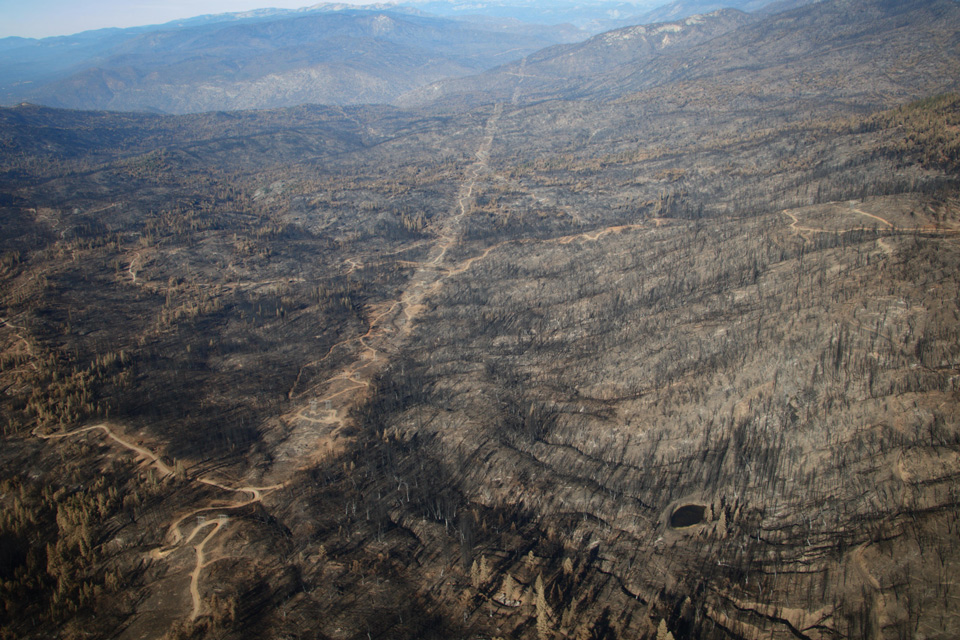
2020 California: Sierra National Forest Creek Fire burn area south of Shaver Lake
Credit: Inciweb
SB11
August 6, 2021 - It's hard to ignore an all-too-common scene looking east to the Sierra, or by stepping outside onto my Butte County farm and into an eerily familiar aromatic smoke. It's wildfire season, again, and I cannot avoid asking myself whether California is any better prepared. Staring at the massive plume emanating from the 250,000-plus acre Dixie Fire fails to instill confidence. Nor does the recent investigative reporting from Capital Public Radio provide any reassurance for my family and others living in or near wildfire-prone areas of California.
Who's to blame for the wildfire crisis? Is it any of California's investor-owned utilities, or the federal government—as most of the fires occur on federal lands? Or is it the state, which arguably has misled the public in overstating the amount of land treated for wildfire? Or is it the environmental community, which helped create an immovable regulatory structure? Or is it local government planners or private homeowners dangerously overbuilding in wildfire-prone communities? The absurdity is, we're running out of fingers to point the blame, and in the echo chamber of wildfire-mitigation rhetoric, political posturing and immovable ideologies, Californians are left to suffer. As frustrations mount, uncertainties present new unforeseen challenges.
The reality is, California's wildfire situation is a massive, multi-dimensional crisis that creates many compounding challenges. The wildfires have not only fundamentally altered landscapes, but also the risk-level assessments and determinations that create other challenges for communities. Farm Bureau members have expressed their frustration with increasing costs of insurance premiums and the frequency of nonrenewals for farms and ranches in areas vulnerable to wildfires. These wildfires are unfortunately becoming larger and more frequent.
Devastating our communities, these fires have left homeowners and businesses behind to deal with the aftermath, which often includes the inability to find available and affordable insurance coverage in the admitted market. Created by statute, the FAIR Plan is an association comprising all insurance companies authorized to transact basic property insurance in California. Established as the state's "insurer of last resort," the FAIR Plan provides access to fire coverage for California homeowners and commercial businesses unable to obtain it from a traditional insurance carrier.
When the voluntary insurance market is unable or unwilling to provide basic property insurance coverage to property owners, they should be able to turn to the FAIR Plan. Yet, California law explicitly prohibited the FAIR Plan from providing insurance coverage for "farm risks." This language was interpreted to exclude not just crops and livestock but all real and personal property—the brick-and-mortar infrastructure of commercial agriculture. As a result, numerous property owners who were being denied basic property insurance coverage in the private market were also unable to obtain such coverage from the FAIR Plan for their agricultural enterprise.
Commercial agriculture was about to experience an unmitigated disaster. The pandemic was creating significant communication hardships. But, by soliciting the assistance of Senate Pro Tem Toni Atkins and Sen. Ben Hueso, a breakthrough was made. There wasn't any question that agriculture was inadvertently prevented from accessing FAIR Plan insurance, but a solution was needed immediately.
Farm Bureau created a multi-stakeholder coalition of our agricultural allies and California's insurance associations to bring forward a solution to solve our availability crisis. Sen. Susan Rubio agreed to champion Senate Bill 11 on behalf of the state's agricultural community. Farm Bureau elevated the crisis to a national audience, bringing attention to a largely unknown problem facing our community as part of the greater wildfire crisis.
In doing so, we gained another significant ally in these conversations—California Insurance Commissioner Ricardo Lara. I appreciate Commissioner Lara's willingness to travel around our state and listen to the challenges and frustrations our members face. The conversations weren't always comfortable, but our commitment to find solutions only grew at each stop.
Just a week ago, Gov. Gavin Newsom signed SB 11 (see related story, Page 6). California agriculture now has access to an insurer of last resort. But this will require further due diligence from our community to make certain farmers, ranchers and vintners are not underinsured.
FAIR Plan insurance is the most basic of insurance coverages. It is not designed to be a carbon-copy replacement of lost coverage, and we need to be aware of potential coverage gaps. As an organization, we intend to provide the opportunities necessary to ensure that our membership is fully informed and adequately prepared.
The signing of this legislation is a welcome relief. As California's wildfire crisis continues, we hope that state leaders move quickly to mitigate the threat but also further examine existing frameworks that may be impacted. It's not just mitigation and suppression; it's about anticipation and uncovering those gaps before another unforeseen crisis occurs.
ABOUT CALIFORNIA FARM BUREAU FEDERATION
The California Farm Bureau Federation works to protect family farms and ranches on behalf of nearly 32,000 members statewide and as part of a nationwide network of more than 5.5 million Farm Bureau members.
Source: Reprinted with permission CFBF








